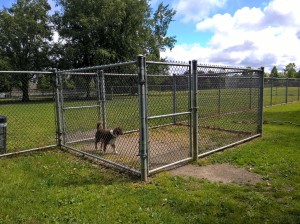Dog Proofing a Yard: Redundant Fencing & Chain-link Air Locks
Redundant Fencing & Chain-link Air Locks
In our previous posts on dog proofing your fence, we covered some of the most important features for securing fences for dogs: using privacy slats, digging under the fence, climbing or jumping over the fence, as well as protecting your pets from predators such as mountain lions (which sometimes wander into yards in Greater Vancouver neighborhoods such as Port Coquitlam, Maple Ridge, and North Vancouver).
In this post we’re covering redundant fencing and air locks — what they are and why you may want to use them.
Redundant fencing
A redundant fence is basically a fence-within-a-fence and there are plenty of important use cases for installing one. One might want to install a redundant fence to keep their dogs out of their garden or pool.
“Fence aggression” is another major reason our customers ask us to install redundant fences. Fence aggression is where dogs are reacting to stimulus on the other side of the fence — sometimes it’s humans or traffic that triggers reactions; or, more commonly, it’s another dog on the other side of the fence.
Fence aggression can be particularly troublesome and difficult to manage when it’s both and your neighbour have reactive dogs sharing a single fence between them.The best recommended solution here is adding a buffer between the dogs via a redundant fence.
How to Install a Redundant Fence
- Privacy Slats: Removing visual stimulus is key for dog reactivity. If the main fence is not a privacy fence, you’ll want to get privacy slats installed to enhance the sense of separation and obscure vision based triggers. We covered the topic of privacy slats for dogs earlier in this series and it’s a recommended read if you have a reactive dog.
- Test the reaction zone: After the privacy slats are installed and visual stimulus is removed, it’s important to test how large the buffer needs to be for your dog(s). Each dog will have its own comfort zone or required distance to feel clam and not react to triggers on the other side of the buffer.To test how large your buffer area needs to be, we can set-up a quick and easy temporary fence and move it as needed until we find the correct distance needed for your dog.
- Install gates and additional controls: this may be optional depending on your situation. For preventing escap artist dogs and for protection from predators, we suggest looking into Concrete Footers, Fence Height, and Top Guards.
Air Locks for Dogs
Air locks with gates are common at dog parks and dog training faculties where dogs might be off-leash and leaving a secure space. They especially useful in areas that need to prevent dogs from accidentally slipping out from an open gate.
Other Tips
When it comes to dog proofing a perimeter with fencing, our customers needs usually fall into three camps: (1) preventing dogs from escaping, (2) protecting the dog from predators, and (3) calming dog reactivity (barking, pacing, anxiety, etc.).
In our previous posts we covered each of these areas with various solutions according to different needs. See:
- Chain-link Fence Dog Proofing (Digging & Climbing)
- How to Dog Proof a Chain Link Fence with Privacy Slats
For reactive dogs we might suggest starting with installing privacy slats and/or redundant fencing.
A Vancouver Fencing Company
If you’re in the Vancouver area and need help installing a dog proof fence, give us a call at 604-345-5145.
We’ll provide a free estimate for the installation costs as well as offer recommendations on be the best solutions for your needs. Ask our professional fencing staff at QS Fencing today!





